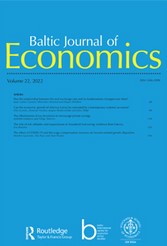Choosing the European fiscal rule
Choosing the European fiscal rule
Author(s): Ginters Bušs, Patrick Grüning, Olegs TkačevsSubject(s): Economic policy, Financial Markets, Public Finances, Fiscal Politics / Budgeting
Published by: BICEPS/SSE Riga
Keywords: Fiscal policy; DSGE; small open economy; fiscal-monetary policy interaction;
Summary/Abstract: In order to quantitatively assess the potential effects from the ongoing transformation of the fiscal framework of the European Union, we evaluate the economic and public finance stabilization properties of two benchmark fiscal rules using a New Keynesian small open economy model. If these fiscal rules are implemented one at a time, having just an expenditure growth rule tends to yield more stable macroeconomic outcomes but more volatile public finances, as compared to having only a structural balance rule. Much of the quantitative differences in relative volatilities can be accounted for by using a modified public expenditure definition in the expenditure growth rule, in particular the removal of debt service payments. The expenditure growth rule with a strong-enough debt anchor strikes the balance between the short-term macroeconomic stability and the medium-term public debt convergence. There is a welfare gain for households from having only an expenditure growth rule.
Journal: Baltic Journal of Economics
- Issue Year: 24/2024
- Issue No: 1
- Page Range: 116-144
- Page Count: 29
- Language: English

